seat adjustment SUBARU IMPREZA 2016 5.G Owners Manual
[x] Cancel search | Manufacturer: SUBARU, Model Year: 2016, Model line: IMPREZA, Model: SUBARU IMPREZA 2016 5.GPages: 594, PDF Size: 5.36 MB
Page 32 of 594

Front seats........................................................... 1-2Forward and backward adjustment ...................... 1-3
Reclining the seatback ........................................ 1-4
Seat height adjustment (driver ’s seat) .................. 1-4
Head restraint adjustment .................................... 1-5
Seat heater (if equipped).................................... 1-6Safety precautions.............................................. 1-6
Operation ............................................................ 1-7
Rear seats ............................................................ 1-7Armrest (if equipped) ........................................... 1-8
Head restraint adjustment .................................... 1-8
Folding down the rear seatback .......................... 1-10
Seatbelts............................................................. 1-11Seatbelt safety tips ............................................. 1-11
Emergency Locking Retractor (ELR) ................... 1-12
Automatic Locking Retractor/Emergency Locking Retractor (ALR/ELR) ......................................... 1-12
Seatbelt warning light and chime ........................ 1-13
Fastening the seatbelt ........................................ 1-13
Seatbelt maintenance ......................................... 1-20
Front seatbelt pretensioners ............................. 1-20Seatbelt with shoulder belt pretensioner .. ........... 1-20Seatbelt with shoulder belt and lap belt
pretensioners .................................................. 1-22
System monitors ............................................... 1-24
System servicing ............................................... 1-24
Precautions against vehicle modification ............ 1-24
Child restraint systems..................................... 1-25Where to place a child restraint system .............. 1-26
Choosing a child restraint system ...................... 1-27
Installing child restraint systems with ALR/ELR seatbelt ........................................................... 1-28
Installing a booster seat ..................................... 1-32
Installation of child restraint systems by use of lower and tether anchorages (LATCH) .............. 1-33
Top tether anchorages ....................................... 1-36
*SRS airbag (Supplemental Restraint
System airbag) ................................................ 1-39
General precautions regarding SRS airbag
system ............................................................ 1-39
Components ...................................................... 1-46
SUBARU advanced frontal airbag system ........... 1-48
SRS side airbag and SRS curtain airbag ............. 1-58
SRS airbag system monitors .............................. 1-67
SRS airbag system servicing ... .......................... 1-69
Precautions against vehicle modification ............ 1-70
Seat, seatbelt and SRS airbags
1
Page 35 of 594
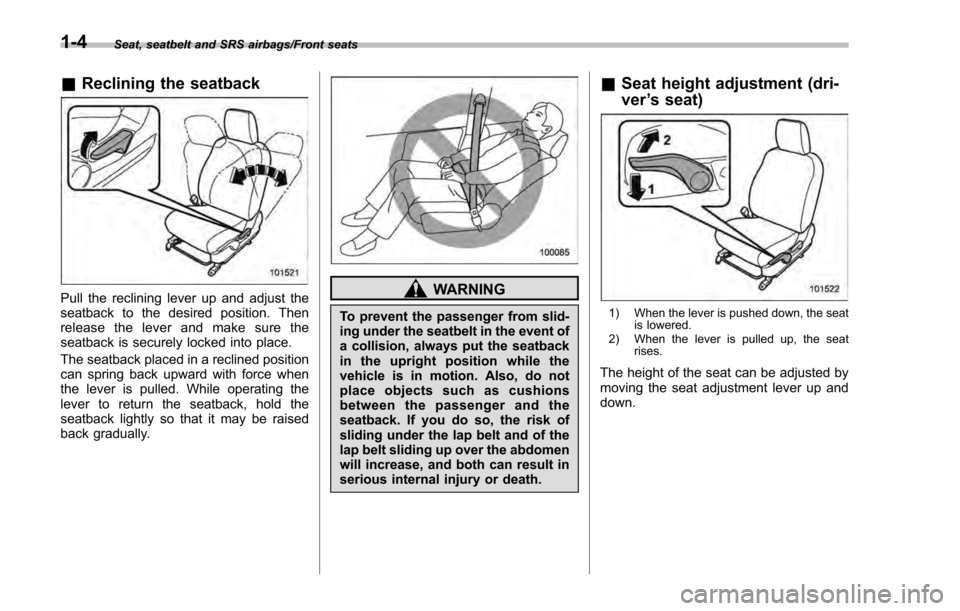
Seat, seatbelt and SRS airbags/Front seats
&Reclining the seatback
Pull the reclining lever up and adjust the
seatback to the desired position. Then
release the lever and make sure the
seatback is securely locked into place.
The seatback placed in a reclined position
can spring back upward with force when
the lever is pulled. While operating the
lever to return the seatback, hold the
seatback lightly so that it may be raised
back gradually.WARNING
To prevent the passenger from slid-
ing under the seatbelt in the event of
a collision, always put the seatback
in the upright position while the
vehicle is in motion. Also, do not
place objects such as cushions
between the passenger and the
seatback. If you do so, the risk of
sliding under the lap belt and of the
lap belt sliding up over the abdomen
will increase, and both can result in
serious internal injury or death.
&Seat height adjustment (dri-
ver ’s seat)
1) When the lever is pushed down, the seat
is lowered.
2) When the lever is pulled up, the seat rises.
The height of the seat can be adjusted by
moving the seat adjustment lever up and
down.
1-4
Page 36 of 594
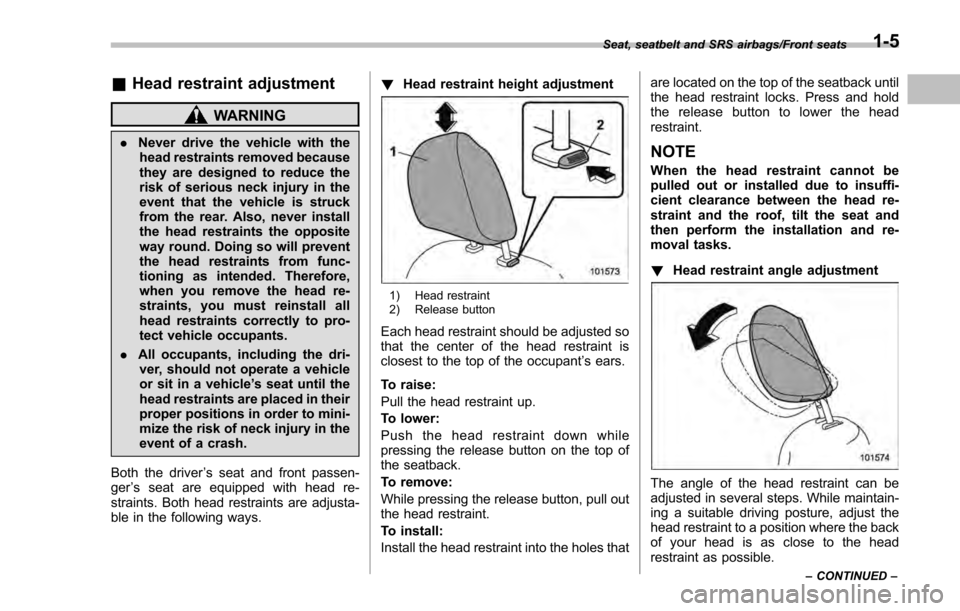
&Head restraint adjustment
WARNING
. Never drive the vehicle with the
head restraints removed because
they are designed to reduce the
risk of serious neck injury in the
event that the vehicle is struck
from the rear. Also, never install
the head restraints the opposite
way round. Doing so will prevent
the head restraints from func-
tioning as intended. Therefore,
when you remove the head re-
straints, you must reinstall all
head restraints correctly to pro-
tect vehicle occupants.
. All occupants, including the dri-
ver, should not operate a vehicle
or sit in a vehicle ’s seat until the
head restraints are placed in their
proper positions in order to mini-
mize the risk of neck injury in the
event of a crash.
Both the driver ’s seat and front passen-
ger ’s seat are equipped with head re-
straints. Both head restraints are adjusta-
ble in the following ways. !
Head restraint height adjustment
1) Head restraint
2) Release button
Each head restraint should be adjusted so
that the center of the head restraint is
closest to the top of the occupant ’s ears.
To raise:
Pull the head restraint up.
To lower:
Push the head restraint down while
pressing the release button on the top of
the seatback.
To remove:
While pressing the release button, pull out
the head restraint.
To install:
Install the head restraint into the holes that are located on the top of the seatback until
the head restraint locks. Press and hold
the release button to lower the head
restraint.
NOTE
When the head restraint cannot be
pulled out or installed due to insuffi-
cient clearance between the head re-
straint and the roof, tilt the seat and
then perform the installation and re-
moval tasks.
!
Head restraint angle adjustment
The angle of the head restraint can be
adjusted in several steps. While maintain-
ing a suitable driving posture, adjust the
head restraint to a position where the back
of your head is as close to the head
restraint as possible.
Seat, seatbelt and SRS airbags/Front seats
–CONTINUED –1-5
Page 39 of 594
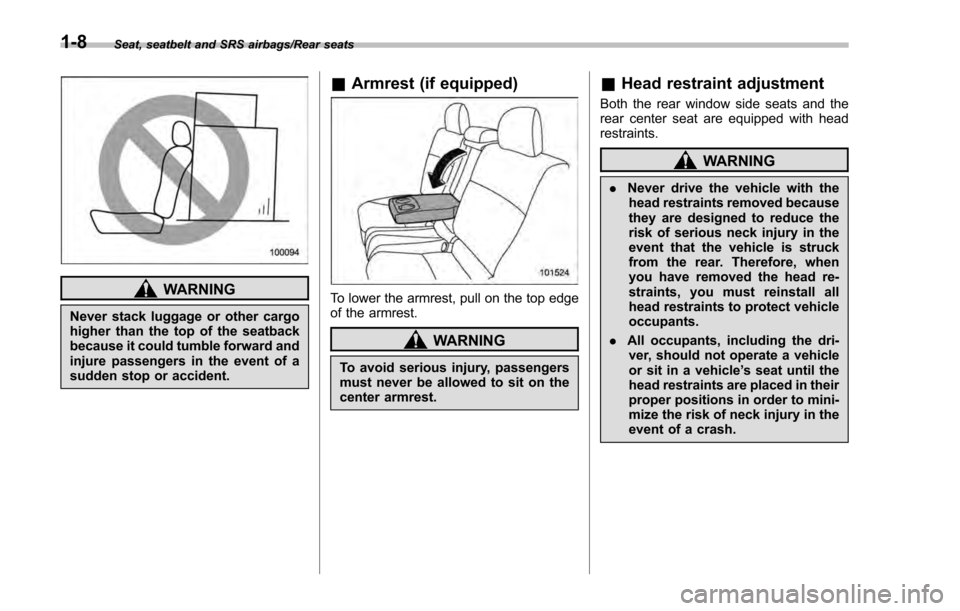
Seat, seatbelt and SRS airbags/Rear seats
WARNING
Never stack luggage or other cargo
higher than the top of the seatback
because it could tumble forward and
injure passengers in the event of a
sudden stop or accident.
&Armrest (if equipped)
To lower the armrest, pull on the top edge
of the armrest.
WARNING
To avoid serious injury, passengers
must never be allowed to sit on the
center armrest.
&Head restraint adjustment
Both the rear window side seats and the
rear center seat are equipped with head
restraints.
WARNING
. Never drive the vehicle with the
head restraints removed because
they are designed to reduce the
risk of serious neck injury in the
event that the vehicle is struck
from the rear. Therefore, when
you have removed the head re-
straints, you must reinstall all
head restraints to protect vehicle
occupants.
. All occupants, including the dri-
ver, should not operate a vehicle
or sit in a vehicle ’s seat until the
head restraints are placed in their
proper positions in order to mini-
mize the risk of neck injury in the
event of a crash.
1-8
Page 80 of 594
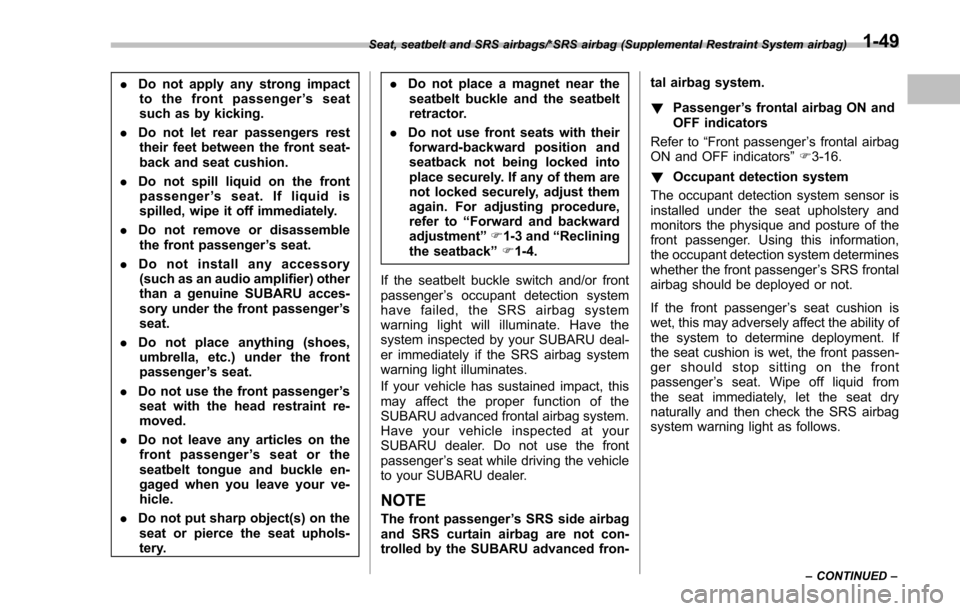
.Do not apply any strong impact
to the front passenger ’sseat
such as by kicking.
. Do not let rear passengers rest
their feet between the front seat-
back and seat cushion.
. Do not spill liquid on the front
passenger ’s seat. If liquid is
spilled, wipe it off immediately.
. Do not remove or disassemble
the front passenger ’s seat.
. Do not install any accessory
(such as an audio amplifier) other
than a genuine SUBARU acces-
sory under the front passenger ’s
seat.
. Do not place anything (shoes,
umbrella, etc.) under the front
passenger ’s seat.
. Do not use the front passenger ’s
seat with the head restraint re-
moved.
. Do not leave any articles on the
front passenger ’s seat or the
seatbelt tongue and buckle en-
gaged when you leave your ve-
hicle.
. Do not put sharp object(s) on the
seat or pierce the seat uphols-
tery. .
Do not place a magnet near the
seatbelt buckle and the seatbelt
retractor.
. Do not use front seats with their
forward-backward position and
seatback not being locked into
place securely. If any of them are
not locked securely, adjust them
again. For adjusting procedure,
refer to “Forward and backward
adjustment” F1-3 and “Reclining
the seatback ”F 1-4.
If the seatbelt buckle switch and/or front
passenger ’s occupant detection system
have failed, the SRS airbag system
warning light will illuminate. Have the
system inspected by your SUBARU deal-
er immediately if the SRS airbag system
warning light illuminates.
If your vehicle has sustained impact, this
may affect the proper function of the
SUBARU advanced frontal airbag system.
Have your vehicle inspected at your
SUBARU dealer. Do not use the front
passenger ’s seat while driving the vehicle
to your SUBARU dealer.
NOTE
The front passenger ’s SRS side airbag
and SRS curtain airbag are not con-
trolled by the SUBARU advanced fron- tal airbag system.
!
Passenger ’s frontal airbag ON and
OFF indicators
Refer to “Front passenger ’s frontal airbag
ON and OFF indicators” F3-16.
! Occupant detection system
The occupant detection system sensor is
installed under the seat upholstery and
monitors the physique and posture of the
front passenger. Using this information,
the occupant detection system determines
whether the front passenger ’s SRS frontal
airbag should be deployed or not.
If the front passenger ’s seat cushion is
wet, this may adversely affect the ability of
the system to determine deployment. If
the seat cushion is wet, the front passen-
ger should stop sitting on the front
passenger ’s seat. Wipe off liquid from
the seat immediately, let the seat dry
naturally and then check the SRS airbag
system warning light as follows.
Seat, seatbelt and SRS airbags/*SRS airbag (Supplemental Restraint System airbag)
–CONTINUED –1-49
Page 255 of 594
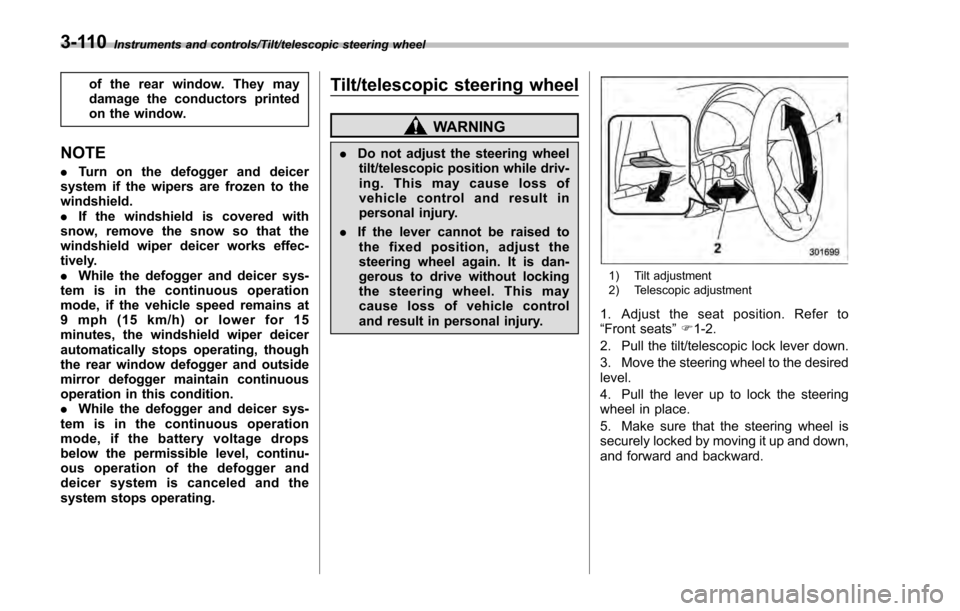
Instruments and controls/Tilt/telescopic steering wheel
of the rear window. They may
damage the conductors printed
on the window.
NOTE
.Turn on the defogger and deicer
system if the wipers are frozen to the
windshield.
. If the windshield is covered with
snow, remove the snow so that the
windshield wiper deicer works effec-
tively.
. While the defogger and deicer sys-
tem is in the continuous operation
mode, if the vehicle speed remains at
9mph(15km/h)orlowerfor15
minutes, the windshield wiper deicer
automatically stops operating, though
the rear window defogger and outside
mirror defogger maintain continuous
operation in this condition.
. While the defogger and deicer sys-
tem is in the continuous operation
mode, if the battery voltage drops
below the permissible level, continu-
ous operation of the defogger and
deicer system is canceled and the
system stops operating.
Tilt/telescopic steering wheel
WARNING
. Do not adjust the steering wheel
tilt/telescopic position while driv-
ing. This may cause loss of
vehicle control and result in
personal injury.
. If the lever cannot be raised to
the fixed position, adjust the
steering wheel again. It is dan-
gerous to drive without locking
the steering wheel. This may
cause loss of vehicle control
and result in personal injury.
1) Tilt adjustment
2) Telescopic adjustment
1. Adjust the seat position. Refer to
“Front seats ”F 1-2.
2. Pull the tilt/telescopic lock lever down.
3. Move the steering wheel to the desired
level.
4. Pull the lever up to lock the steering
wheel in place.
5. Make sure that the steering wheel is
securely locked by moving it up and down,
and forward and backward.
3-110
Page 393 of 594

Starting and operating/Preparing to drive
.A vehiclefails the OBDII inspection if
the “CHECK ENGINE ”warning light is not
properly operating (light is illuminated or is
not working due to a burned out bulb) or
there is one or more diagnostic trouble
codes stored in the vehicle’ s computer.
. A state emission inspection may reject
(not pass or fail) a vehicle if the number of
OBDII system readiness monitors “NOT
READY ”is greater than one. If the
vehicle’ s battery has been recently re-
placed or disconnected, the OBDII system
inspection may indicate that the vehicle is
not ready for the emission test. Under this
condition, the vehicle driver should be
instructed to drive his/her vehicle for a few
days to reset the readiness monitors and
return for an emission re-inspection.
. Owners of rejected or failing vehicles
should contact their SUBARU Dealer for
service.
Some states still use dynamometers in
their emission inspection program. A
dynamometer is a treadmill or roller-like
testing device that allows your vehicle ’s
wheels to turn while the vehicle remains in
one place. Prior to your vehicle being put
on a dynamometer, tell your emission
inspector
not to place your SUBARU
AWD vehicle on a two-wheel dynam-
ometer. Otherwise, serious transmis-
sion damage will result. The U.S. Environmental Protection
Agency (EPA) and states using two-wheel
dynamometers in their emission testing
program have EXEMPTED SUBARU
AWD vehicles from the portion of the
testing program that involves a two-wheel
dynamometer. There are some states that
use four-wheel dynamometers in their
testing program. When properly used, this
equipment should not damage a SUBARU
AWD vehicle.
Under no circumstances should the rear
wheels be jacked off the ground, nor
should the driveshaft be disconnected for
state emission testing.
Preparing to drive
You should perform the following checks
and adjustments every day before you
start driving.
1. Check that all windows, mirrors, and
lights are clean and unobstructed.
2. Check the appearance and condition
of the tires. Also check tires for proper
inflation.
3. Look under the vehicle for any sign of
leaks.
4. Check that the hood, trunk (4-door)
and rear gate (5-door) are fully closed.
5. Check the adjustment of the seat.
6. Check the adjustment of the inside
and outside mirrors.
7. Fasten your seatbelt. Check that your
passengers have fastened their seatbelts.
8. Check the operation of the warning
and indicator lights when the ignition
switch is turned to the
“ON ”position.
9. Check the gauges, indicator and warn-
ing lights after starting the engine.
10. Check that no small animals enter the
engine compartment.
7-8
Page 582 of 594

EngineCompartment overview ........................................... 11-7
Coolant ........................................................ 11-11, 12-7
Exhaust gas (carbon monoxide) ............................. 5, 8-2
Hood .................................................................... 11-5
Low oil level warning light ....................................... 3-18
Oil................................................................ 11-8, 12-4
Overheating .......................................................... 9-13
Starting & stopping ........................................... 7-9, 7-12
Event data recorder ......................................................... 8
Exterior care .............................................................. 10-2
F
Flat tires ..................................................................... 9-6
Floor mat .................................................................. 6-11
Fluid level Brake .................................................................. 11-16
Clutch .................................................................. 11-17
Continuously variable transmission .......................... 11-15
Fog light Bulb .......................................................... 11-38, 12-14
Indicator light ......................................................... 3-31
Switch .................................................................. 3-94
Front
Differential gear oil ........................................ 11-15, 12-6
Seatbelt pretensioners ............................................ 1-20
Turn signal light .................................................... 11-38
Front seats .................................................................. 1-2
Forward and backward adjustment ............................. 1-3
Head restraint adjustment ......................................... 1-5
Reclining ................................................................. 1-4 Seat height adjustment
............................................. 1-4
Fuel ........................................................................\
... 7-3
Consumption indicator ............................................. 3-33
Consumption screen ............................................... 3-48
Economy hints ........................................................ 8-2
Filler lid and cap ...................................................... 7-4
Gauge ................................................................... 3-12
Requirements ................................................. 7-3, 12-3
Fuses ..................................................................... 11-35
Fuses and circuits .................................................... 12-10
G
GAWR (Gross Axle Weight Rating) ............................... 8-13
Glove box ................................................................... 6-6
GVWR (Gross Vehicle Weight Rating) ........................... 8-13
H
Hands-free phone system ............................................ 5-71
Hazard warning flasher .......................................... 3-8, 9-2
Head restraint adjustment Front seat ............................................................... 1-5
Rear seat ............................................................... 1-8
Headlight Beam leveler. ......................................................... 3-94
Bulb replacing ...................................................... 11-36
Bulb wattage ........................................................ 12-14
Control switch ........................................................ 3-89
Flasher .................................................................. 3-91
Indicator light .........................................................
3
-32
Welcome lighting function ........................................ 3-90
HID headlights ...................................................... 1, 11-36
Index14-5
Page 585 of 594

14-8Index
Overheating engine.................................................... 9-13
P
Parking Brake ................................................................... 7-40
Brake stroke ......................................................... 11-21
Light .................................................................... 11-38
Tips...................................................................... 7-40
Periodic inspections ..................................................... 8-4
Petrol fuel ................................................................... 7-3
PIN Code Access ...................................................... 2-21
Power Door locking switch .................................................. 2-8
Outlets .................................................................... 6-8
Outside mirrors .................................................... 3-108
Steering ................................................................ 7-30
Steering warning light ............................................. 3-23
Windows ............................................................... 2-35
Precautions against vehicle modification ............... 1-24, 1-70
Preparing to drive ........................................................ 7-8
Push-button Ignition switch .......................................................... 3-6
Starting and stopping engine ................................... 7-12
R
Rear Combination lights ................................................. 11-38
Differential gear oil ........................................ 11-15, 12-6
Gate ............................................................. 2-41, 9-19
Turn signal light .................................................... 11-38
Rear seat .................................................................... 1-7 Armrest
.................................................................. 1-8
Folding down ......................................................... 1-10
Head restraint adjustment ......................................... 1-8
Rear view camera ...................................................... 6-15
How to adjust the rear view image ............................ 5-25
Rear window Defogger ............................................................. 3-108
Wiper and washer switch ......................................... 3-99
Wiper blades ........................................................ 11-32
Recommended Brake fluid ............................................................. 12-7
Continuously variable transmission fluid .................... 12-7
Engine oil .............................................................. 12-4
Front differential gear oil .......................................... 12-6
Rear differential gear oil .......................................... 12-6
Spark plugs ........................................................... 12-7
Refueling .................................................................... 7-5
Remote engine start system ........................................ 7-14
Remote keyless entry system ...................................... 2-23
Replacement Access key battery ............................................... 11-44
Air cleaner element ............................................... 11-13
Brake pad and lining ............................................. 11-20
Lost transmitters (remote keyless entry system) ......... 2-26
Remote engine start transmitter battery ..................... 7-20
Remote keyless entry transmitter battery ................. 11-45
Wiper blades ........................................................ 11-30
Replacing bulbs.............................................
11-36, 12-14
Backup light ......................................................... 11-38
Cargo area light ................................................... 11-42
Dome light ........................................................... 11-42